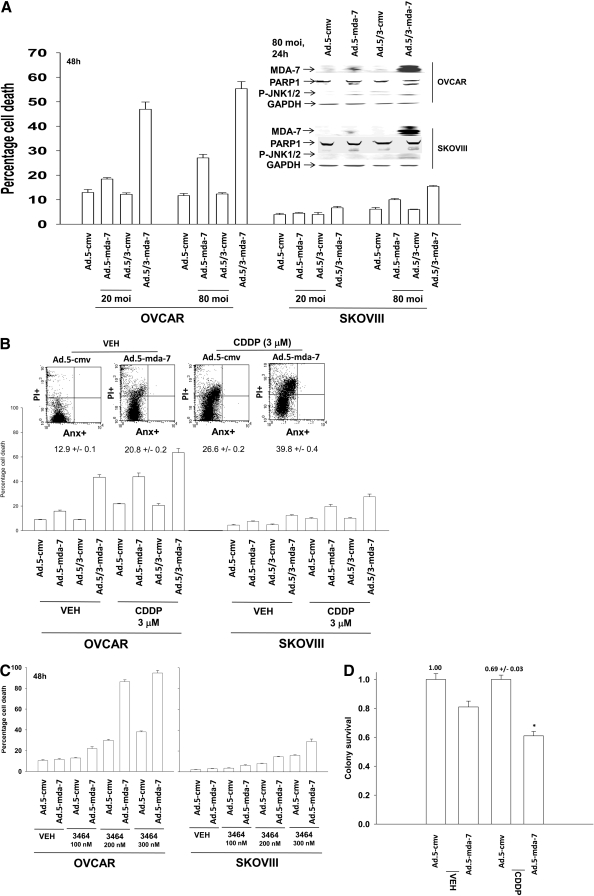Fig. 3.
A tropism-modified type 5/type 3 virus infects ovarian cancer cells more readily than a type 5 virus and enhances cisplatin toxicity. A, OVCAR and SKOVIII cells were infected with Ad.5-cmv or Ad.5-mda-7 or with tropism-modified viruses Ad.5/3-cmv or Ad.5/3-mda-7 at an m.o.i. of 20 or 80, as indicated. Cells were isolated 48 h after infection, and the loss of cell viability was determined by trypan blue exclusion assays in triplicate (± S.E.M., n = 3). Inset, cells were infected with the indicated viruses, and 24 h after infection, cells were isolated to determine the expression of MDA-7/IL-24 and the cleavage status of PARP1. B, OVCAR and SKOVIII cells were infected with Ad.5-cmv or Ad.5-mda-7 or with tropism-modified viruses Ad.5/3-cmv or Ad.5/3-mda-7 at an m.o.i. of 80. Twenty-four h after infection, cells were treated with vehicle or cisplatin (CDDP, 3 μM). Seventy-two hours after infection, cells were isolated, and the loss of cell viability was determined by trypan blue exclusion assays in triplicate (± S.E.M., n = 3). Inset, identical portions of OVCAR cells, infected as indicated, were isolated 72 h after exposure, and the loss of cell viability was determined by using Annexin V/propidium iodide staining assays in triplicate using a flow cytometer (± S.E.M., n = 3). C, OVCAR and SKOVIII cells were infected with Ad.5-cmv or Ad.5-mda-7 at an m.o.i. of 80, and 24 h after infection, cells were treated with vehicle or BBR3464 (BBR3464, 100–300 nM). Forty-eight hours after infection, cells were isolated, and the loss of cell viability was determined by trypan blue exclusion assays in triplicate (± S.E.M., n = 3). D, OVCAR cells were plated in sextuplicate as single cells were infected with Ad.5-cmv or Ad.5-mda-7 at an m.o.i. of 80, and 24 h after infection, cells were treated with vehicle or cisplatin (CDDP, 3 μM). The media were changed to drug-free media 48 h after CDDP treatment, and colonies were permitted to form for 10 to 14 days (± S.E.M., n = 2).

